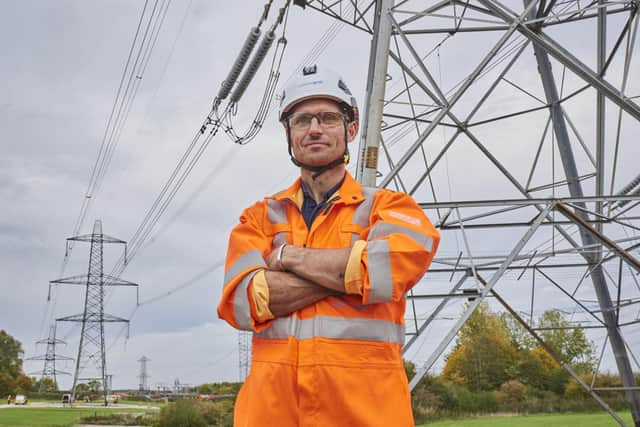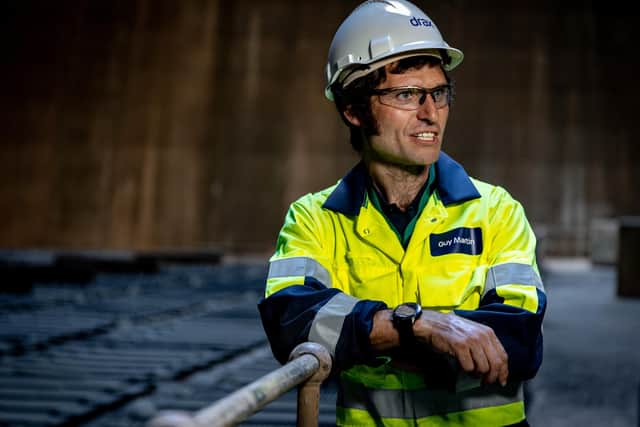Guy Martin's Great British Power Trip: New show investigates how country makes its energy
“To fly from on end to the other in a fast helicopter took 20 minutes,” he says. “And when you're on top of a turbine, you can't see the one furthest away because of the curvature of the Earth.”
The Lincolnshire lorry mechanic and motorcycle racer visited Hornsea Two for a new television series in which he explores the past, present and future of British energy.
Advertisement
Hide AdAdvertisement
Hide AdIn Guy Martin’s Great British Power Trip, he looks at how the country makes its power and why it costs so much. He gets to work at every stage of the energy production process – from inside the boiler at the country’s biggest power station, to the top of the highest pylons, and inside the most advanced nuclear fusion lab in the world.


"I originally wanted to do something about how renewable energy worked because I was sceptical about it – installing wind turbines off-shore and importing solar panels from China felt energy-intensive to me,” Guy explains.
“Then we had this energy crisis business and so we went from covering renewables to all forms of power and why our electricity bills are so dear.”
The Channel 4 series begins with Guy testing every piece of equipment in his own workshop to find out which items use the most electricity. Horrified by what he’s now having to pay for power, Guy tries to work out the reasons behind his big bills.
Advertisement
Hide AdAdvertisement
Hide AdHe starts at his local power station – which also happens to be the country’s biggest, going deep inside Drax, near Selby, and operating its mills and boilers to see how the wood pellets it burns are actually turned into electricity.


Along the way on his energy adventure, Guy climbs to the top of a pylon to try his hand at being an electrical grid linesman, one of the riskiest maintenance jobs in the world, before then helping an explosives team in the demolition of one of Britain’s oldest coal-burning power stations – Eggborough, in North Yorkshire.
“It was an amazing honour to set the big bang off and press the button,” he says. “It was just a job that needed doing. It surprised me that power stations like that have a lifespan and at the end of that lifespan they blow them up, because it’s safer than sending in workers to start dismantling knackered old buildings.
“The part that I played was a tiny part. It was a steel structure holding up a concrete building and they had been there three weeks before plugging all the weak spots in all these steel structures and putting all the explosives in the right place. It was a very calculated affair. Nobody on the explosives crew is ever that keen to press “fire” but I said I didn’t mind.”
Advertisement
Hide AdAdvertisement
Hide AdThis second episode begins at the most important place in the entire National Grid – the central control room, where electricity is bought, sold and routed every single second of the day. Tasked with the challenging job of keeping the country’s lights on, Guy spends thousands of pounds in just a few minutes balancing the electricity supply and demand market.
Guy’s attention then turns to the rise of renewable energy – first working with the army, who are pioneering a new solar-powered workshop, before embarking on the gruelling training required to become an off-shore wind farm technician. Guy flies off the Yorkshire coast to find out how a power station in the middle of the North Sea can possibly work.
Hornsea Two – made up of 165 wind turbines, became fully operational last year. Spanning an area equal to more than 64,000 football pitches or 31 Lake Windermeres, one revolution of the turbine blades at the farm can power an average UK home for 24 hours.
In the final episode, Guy investigates the future of energy production and explores what part nuclear will play in generating our electricity. “The only realistic thing is a big mixture of everything,” he says, when asked how he thinks homes will be powered in the future. No energy source is the perfect answer.
Advertisement
Hide AdAdvertisement
Hide Ad"Wind farms are great, but sometimes the wind doesn’t blow. Solar is great, but the sun sets every day. Nuclear produces loads of power, but costs loads of money to build. So you need a mix of all to make sure the pros are covering the cons."
Guy Martin’s Great British Power Trip airs on Sunday, February 12 at 9pm on Channel 4.
